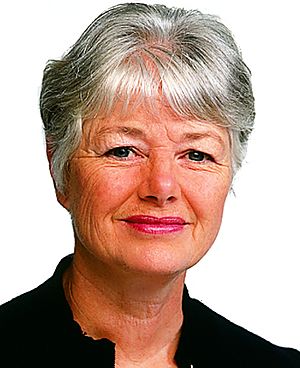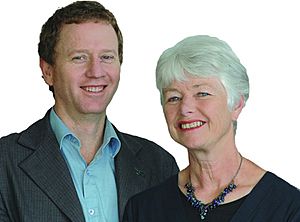Jeanette Fitzsimons facts for kids
Quick facts for kids
Jeanette Fitzsimons
|
|
|---|---|
 |
|
| 1st Female co-leader of the Green Party | |
| In office 21 May 1995 – 30 May 2009 Co-leading with Rod Donald, then Russel Norman
|
|
| Succeeded by | Metiria Turei |
| Member of the New Zealand Parliament for Green Party list |
|
| In office 27 July 2002 – 11 February 2010 |
|
| Succeeded by | Gareth Hughes |
| Member of the New Zealand Parliament for Coromandel |
|
| In office 27 November 1999 – 27 July 2002 |
|
| Preceded by | Murray McLean |
| Succeeded by | Sandra Goudie |
| Majority | 250 (0.73%) |
| Member of the New Zealand Parliament for Alliance party list |
|
| In office 12 October 1996 – 27 November 1999 |
|
| Personal details | |
| Born |
Jeanette Mary Gaston
17 January 1945 Dunedin, New Zealand |
| Died | 5 March 2020 (aged 75) Thames, New Zealand |
| Political party | Green Party Alliance Values Party |
| Spouses |
1. Bevin Fitzsimons
(m. 1966; div. 1986)2. Harry Parke
(m. 1994) |
| Children | 2 |
| Alma mater | University of Auckland |
Jeanette Fitzsimons was an important New Zealand politician and a strong supporter of protecting the environment. She was born on 17 January 1945 and passed away on 5 March 2020.
Jeanette was a co-leader of the Green Party of Aotearoa New Zealand from 1995 to 2009. She also served as a Member of Parliament (MP) from 1996 to 2010.
Contents
Early Life and Education
Jeanette Mary Gaston was born in Dunedin, New Zealand, on 17 January 1945. She grew up in nearby Mosgiel and later in Waiuku, near Auckland.
She went to Waiuku District High School and then Epsom Girls' Grammar School in Auckland. Jeanette studied French and music at the University of Auckland. She earned a Bachelor of Arts degree and was known as a talented violinist. She also received a Diploma of Education.
Becoming an Environmentalist
After teaching for a few years, Jeanette lived in Geneva, Switzerland, from 1968 to 1974. There, she joined groups like Friends of the Earth and the Environmental Defence Society. These groups work to protect nature.
Her father sent her news about the Values Party in New Zealand. This party was focused on environmental issues. When Jeanette returned to New Zealand in 1974, she joined the Values Party.
From 1980 to 1992, Jeanette taught about environmental studies and energy at the University of Auckland. She also worked with other environmental groups and advised local councils on green issues.
Political Journey
Jeanette Fitzsimons started her political career with the Values Party. She was their spokesperson for energy from 1977 to 1982. She ran for election in 1978 and 1981 but was not successful.
Later, the Values Party joined with other groups to form the Green Party. Jeanette became a very active member of this new party.
Joining the Alliance Party
The Green Party then teamed up with other left-wing parties to create the Alliance Party. Jeanette became a co-deputy leader of the Alliance from 1992 to 1999.
In 1995, she became a co-leader of the Green Party. The Green Party was still part of the Alliance at this time.
Becoming a Member of Parliament
| New Zealand Parliament | ||||
| Years | Term | Electorate | List | Party |
| 1996–1999 | 45th | List | 3 | Alliance |
| 1999–2002 | 46th | Coromandel | 1 | Green Party of Aotearoa New Zealand |
| 2002–2005 | 47th | List | 1 | Green Party of Aotearoa New Zealand |
| 2005–2008 | 48th | List | 1 | Green Party of Aotearoa New Zealand |
| 2008–2010 | 49th | List | 1 | Green Party of Aotearoa New Zealand |
In the 1996 election, New Zealand used a new voting system called MMP. Jeanette was placed third on the Alliance party list. This meant she entered Parliament as a Member of Parliament (MP).
In 1998, Jeanette proposed a new law called the Energy Efficiency Bill. This bill aimed to make New Zealand use energy more wisely. It later became law as the Energy Efficiency and Conservation Act 2000.
For the 1999 election, the Green Party ran as a separate party. Jeanette and Rod Donald were their co-leaders. Jeanette ran for the Coromandel seat. The Green Party needed to win an electorate seat or get five percent of the national vote to enter Parliament.
The Labour Party leader, Helen Clark, even asked her supporters to vote for Jeanette in Coromandel. Jeanette won the Coromandel seat by a very small number of votes. This helped the Green Party get seats in Parliament.
In the 2002 election, Jeanette did not win the Coromandel seat. However, she remained an MP because she was high on the Green Party's list. She continued to be the Green Party's co-leader until 2009.
After the 2005 election, Jeanette became the spokesperson for the government's plans to promote solar heating. She also worked on bills related to climate change.
Jeanette left Parliament on 11 February 2010. She was replaced by Gareth Hughes.
After Politics
Even after leaving Parliament, Jeanette Fitzsimons stayed very involved in environmental causes.
- In 2013, she joined a protest against oil drilling off the coast of Raglan.
- In 2017, she protested against a company's use of coal by chaining herself to a gate.
She was also a supporter of the Soil & Health Association and advised the University of Otago Centre for Sustainability.
Awards and Recognition
Jeanette Fitzsimons received several honours for her work:
- The New Zealand Herald newspaper named her New Zealand Politician of the Year in 2007.
- In 2008, a poll found that people thought she was the most trustworthy political party leader in New Zealand.
- In 2010, she was appointed a Companion of the New Zealand Order of Merit for her public service. This is a special award in New Zealand.
Personal Life
Jeanette Fitzsimons was married twice. She married Bevin Fitzsimons in 1966. They lived in Geneva, Switzerland, for six years and had two sons there. They divorced in 1986.
In 1994, she married Harry Renford Parke. In 1991, Jeanette and Harry bought land in the Kauaeranga Valley near Thames. They started a farm called Pakaraka Farm. This farm uses solar power and micro-hydro power (small-scale water power) for its energy. They sold products like olive oil, chestnuts, and pecans from their farm.
Death
On 5 March 2020, Jeanette Fitzsimons had a fall on her farm. She passed away later that day in Thames Hospital from a stroke. She was 75 years old. Many politicians, including the Prime Minister Jacinda Ardern, shared their sadness and paid tribute to her important work.


